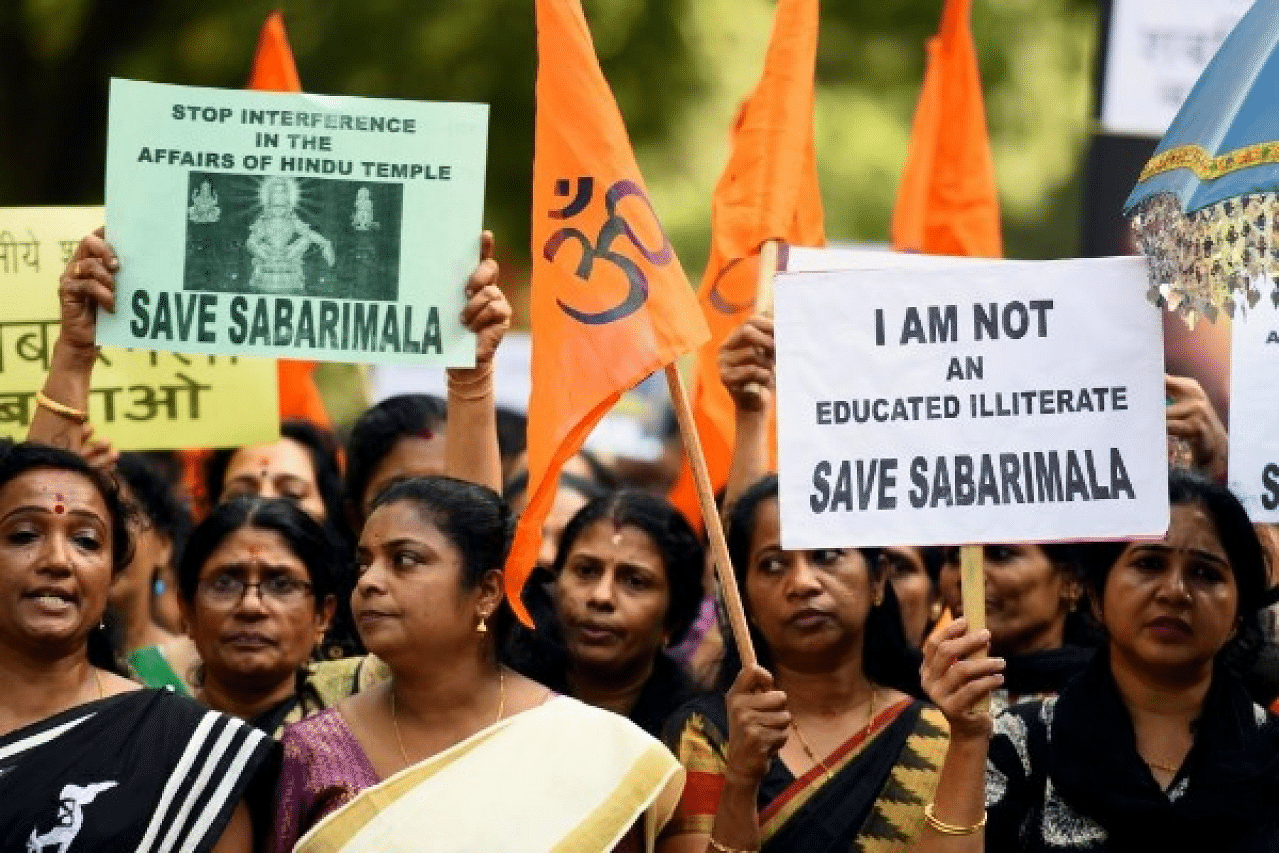News Brief
Sabarimala Review: ‘A Foot In The Door’ Say Those Defending Tradition As SC Refers Case To Larger Bench
- Of the five judges, three have said that the review petitions raised serious questions about faith and practices of a religious denomination or sect.
- The majority judgment is, however, silent on staying the earlier judgment of allowing women of reproductive age to enter the Ayyappa shrine.

Some hope for Ayyappa devotees as SC rules 3:2 to refer the case to a larger bench.
Did the Supreme Court lay the ground for its judgment on the Sabarimala review petition in its ruling on the Ram Janambhoomi case?
The apex court has decided to review its ruling to allow entry of women of reproductive age into the Sabarimala Ayyappa temple to a larger seven-judge bench. Three judges favoured the review, while two opposed.
In its judgment on Ram Janmabhoomi, the apex court, in its unanimous verdict, said: “faith and belief is beyond the ken of judiciary”.
In its ruling on the Sabarimala review petitions today (14 November), three of the judges — Chief Justice Ranjan Gogoi, Justice A M Khanwilkar and Justice Indu Malhotra — said the review petitions raised serious questions about faith and practices of a religious denomination or sect.
The three judges also said that the same bench can take up the issue of entry of women into a mosque and an Agiyari.
Justices D Y Chandrchud and Rohinton Nariman stuck to their earlier stand taken in September last year of quashing the custom of barring women’s entry into the Sabarimala Ayyappa temple.
The bench that reviewed last year's ruling was practically the same with Chief Justice Gogoi replacing his predecessor Deepak Mishra. Last year's ruling was decided by a majority of 4:1 with Justice Indu Malhotra being the lone dissenter.
In this ruling, Chief Justice Gogoi and Justice Khanwilkar have gone along with Justice Malhotra.
The majority judgment was, however, silent on staying the earlier judgment of allowing women of reproductive age to enter the Ayyappa shrine.
The earlier judgment can be stayed by the seven-judge bench when it takes up the case or until it hears the issue fresh and gives its ruling.
The ruling is seen as “one foot in the door” by those who have followed the traditions and customs of the Ayyappa temple. The followers, including the Pandalam Royal family — that has a huge stake in the temple — were upset over last year’s ruling.
The Supreme Court allowed the entry of women of reproductive age, ruling on a petition filed by a group of five women lawyers, although only one preferred to stand by it in the end.
Their petition was taken up by the Indian Young Lawyers Association, which, at that time, was headed by Naushad Ahmad Khan.
The Supreme Court was petitioned after the Kerala High Court upheld the customs and practices of the Sabarimala temple.
The Travancore Devaswom Board changed its stance during the hearing. Initially, it had opposed the entry of women of all age groups. But after the Left Democratic Front (LDF) came to power in 2016, the board favoured the entry of women or all ages.
The Supreme Court ruling led to widespread protests in Kerala, mainly led by women.
Violence was witnessed as Ayyappa devotees tried to prevent women of reproductive age from entering the temple, while the Communist Party of India-Marxist (CPI(M)) government insisted on implementing the ruling.
The protests led to a general bitterness towards the CPI(M) government in Kerala that led to its drubbing in the Lok Sabha polls in May this year. The LDF was able to win only one of the 20 seats that were at stake in Kerala.
The BJP, on the other hand, had high stakes in the protests against allowing women of all ages into the Ayyappa temple but it was the Congress that gained in the end.
Quite a few women, none of whom were followers of Ayyappa, including rationalists, non-believers, and Muslims, attempted to enter the temple. The LDF government even clandestinely arranged for the entry of two women into the temple, leading to further controversy.
Another woman claimed that she had dyed her hair white and entered the temple but this was never verified.
The protests during the peak Ayyappa season affected the flow of pilgrims to the temple in particular, and Kerala, in general. This affected the income to the temples in the form of devotees’ offerings.
At one point of time, devotees resorted to donating only one or two rupee coins to Kerala temples as a protest against the government’s decision to implement the Supreme Court ruling by force.
The ruling on the review petition will likely result in the Kerala government adopting a wait and watch attitude, political analysts say.
Introducing ElectionsHQ + 50 Ground Reports Project
The 2024 elections might seem easy to guess, but there are some important questions that shouldn't be missed.
Do freebies still sway voters? Do people prioritise infrastructure when voting? How will Punjab vote?
The answers to these questions provide great insights into where we, as a country, are headed in the years to come.
Swarajya is starting a project with an aim to do 50 solid ground stories and a smart commentary service on WhatsApp, a one-of-a-kind. We'd love your support during this election season.
Click below to contribute.
Latest